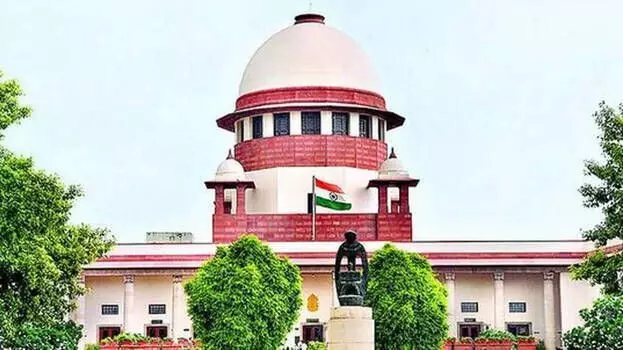New bench to decide AMU minority status, says SC as it overrules 1967 verdict
The CJI outlined the factors which must be used to determine if a minority has "established" an educational institution
By Newsmeter Network
Supreme Court (file photo)
New Delhi: The contentious legal question over Aligarh Muslim Unversity's minority status would be decided by a new bench, the Supreme Court held on Friday and overruled the 1967 judgement that said the university cannot be considered a minority institution since it was created by a central law.
In a 4:3 majority verdict, a Constitution bench headed by Chief Justice D Y Chandrachud, said a legislation or an executive action that discriminated against religious or linguistic minorities in establishing or administering educational institutions, was ultra vires Article 30(1) of the Constitution.
Article 30 deals with the right of minorities to establish and administer educational institutions. Article 30 (1) says all minorities, whether based on religion or language, shall have the right to establish and administer educational institutions of their choice.
"The view taken in Azeez Basha (1967 verdict) that an educational institution is not established by a minority if it derives its legal character through a statute, is overruled," held the CJI, who authored the 118-page verdict, also on behalf of Justices Sanjiv Khanna, J B Pardiwala and Manoj Misra.
A five-judge Constitution bench in the S Azeez Basha v. Union of India in 1967 said AMU was a central university and couldn't be considered a minority institution.
"Additionally, a linguistic or religious minority which has established an educational institution receives the guarantee of greater autonomy in administration. This is the 'special rights' reading of the provision," the majority verdict said.
Justice Chandrachud held that religious or linguistic minorities must prove that they established the educational institution for the community to be a minority educational institution for the purposes of Article 30(1).
"The right guaranteed by Article 30(1) is applicable to universities established before the commencement of the Constitution," he said.
The CJI outlined the factors which must be used to determine if a minority has "established" an educational institution.
"The indicia of ideation, purpose and implementation must be satisfied. The idea for establishing an educational institution must have stemmed from a person or group belonging to the minority community and the educational institution must be established predominantly for the benefit of minority community," he wrote.
Implementation of the idea was stated to be another factor taken by the members of the minority community.
"The administrative-set up of the educational institution must elucidate and affirm (i) the minority character of the educational institution; and (ii) that it was established to protect and promote the interests of the minority community," it said.
The question whether AMU was a minority educational institution must be decided based on the principles laid down in the judgment, it underscored.
Judicial records of the case were, therefore, directed to be placed before a regular bench, after receiving instructions from the CJI on the administrative side, for deciding the minority issue and adjudicating appeals against a 2006 verdict of the Allahabad High Court, which struck down a provision of the 1981 law according minority status to AMU.
The majority verdict also held the 1981 reference by a two-judge bench, which had questioned the correctness of the 1967 verdict and had referred the matter to a seven-judge bench, was valid.
Three other judges -- Justices Surya Kant, Dipankar Datta and Satish Chandra Sharma -- on the seven-judge Constitution bench wrote separate opinions.
Justice Kant said the 1981 reference for reconsideration of the 1967 decision was "bad in law and ought to be set aside".
"The reference by the two-judge bench in Anjuman (in 1981) is nothing but a challenge to the authority of the chief justice of India being the master of the roster and in derogation of the special powers enjoyed upon under Article 145 of the Constitution...," he wrote in a separate 102-page verdict.
Justice Datta, in his 88-page opinion, declared AMU not to be a minority educational institution.
"I am left to wonder how the bench of two judges in Anjuman-e-Rahmania could at all request that the case be placed before a bench of at least seven judges," he wrote, adding, "... I am afraid, tomorrow, a bench of two judges, referring to opinions of jurists could well doubt the 'basic structure' doctrine and request the Chief Justice of India to constitute a bench of 15 judges."
In a 193-page judgment, Justice Sharma said the two-judge bench could not have referred the matter to a bench of seven judges directly without the CJI being a part of the bench.
The top court had on February 12, 2019, referred to a seven-judge bench the contentious issue and a similar reference was made in 1981 previously.
The fabled educational institution, however, got back its minority status when Parliament passed the AMU (Amendment) Act in 1981.
The Congress-led UPA government at the Centre had moved in appeal against the high court's 2006 verdict apart from the university filing a separate petition against it.
The BJP-led NDA government informed the Supreme Court in 2016 that it would withdraw the appeal filed by the erstwhile UPA dispensation.
It had cited the 1967 judgement in the Basha case to claim that AMU was not a minority institution since it was a central university funded by government.
Inputs from PTI